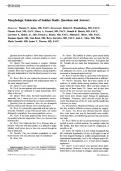JACC Vol. 5. NO.6 798
June 1985:79B-80B
Morphologic Substrates of Sudden Death: Questions and Answers
Moderator: Thomas N. James, MD, FACC; Discussants: Robert O. Brandenburg, MD, FACC,
Charles Fisch, MD, FACC, Harry A. Fozzard, MD, FACC, Donald B. Hackel, MD, FACC,
Lawrence E. Hinkle, Jr., MD, Francis J. Klocke, MD, FACC, Michael F. Oliver, MD, FACC,
Suzanne Oparil, MD, Lino Rossi, MD, Borys Surawicz, MD, FACC, Jack L. Titus, MD, PhD,
Mario Vassalle, MD, James V. Warren, MD, FACC
Questionfrom the audience: How often is pressure over- Dr. James: The inability to relate a given neural lesion
load compared with volume overload a problem in ventric- to a particular kind of arrhythmia does not mean that the
ular hypertrophy? neural lesion was not important, however. I recognize that
Dr. Oparil: The usual situation is complex. Multiple Dr. Vassalle did not make that interpretation, but others
processes and factors contribute to the pathogenesis of ven- might.
tricular hypertrophy. Even with arterial hypertension, for Question from the audience: When you find inflammatory
example, there may be genetic influences causing hypertro- cell infiltration of a nerve, is its functional significance of
phy quite independent of what the blood pressure level may increased or decreased neural activity?
be. Dr. Rossi: It may be either at a given time of the process,
Dr. Rossi: How do you explain the presence of normal and eventually end in inactivity if the destruction is sufficient.
myocardial fibers intermingled with hypertrophied fibers in Dr. Warren: Recently, there have been reports of an
the same enlarged heart? epidemic of sudden deaths among southeast Asian immi-
Dr. Oparil: I can't explain that. grants within the United States. Have you had a chance to
Dr. Fisch: In some patients with ventricular hypertrophy, study any of those hearts, Dr. James, and do they have
large Q waves are attributed to septal hypertrophy. How lesions of the sort you have just been describing?
often is this true? Dr. James: I have not examined such hearts. However,
Dr. Oparil: More often, the heart hypertrophies sym- more recent news releases report findings by pathologists
metrically, but I cannot give you a quantitative answer. in Memphis, Tennessee, which describe exactly the per-
Other explanations for the large Q wave merit consideration. sistent fetal dispersion of the AV node and His bundle that
Question from the audience: How do you distinguish I showed you today.
between afferent and efferent nerves histologically? Dr. Brandenburg: Multifocal Purkinje cell tumors look
Dr. Rossi: It is practically impossible with the light mi- like they would be difficult to remove entirely by surgery.
croscope. Similarly, except with special stains, one cannot Dr. James: Yes, but as you will hear from Dr. Garson
distinguish sympathetic from parasympathetic nerves. later, some tumor sites may be functionally more trouble-
Dr. Fisch: It has been proposed that nerves distal to a some than others, and identifying and removing such tumors
myocardial infarction degenerate. Have you observed that may help.
anatomically? Dr. Rossi: There are also occasional Purkinje cell tumors
Dr. Rossi: Not within the first 24 or 48 hours after in- located in such a critical position, for example within the
farction. And even with later studies, it is difficult to judge His bundle, that their removal would be complicated, if
whether small nerves have or have not coursed through an possible at all.
area of infarction. Dr. James: Dr. Oparil, it is now widely recognized that
Dr. Vassalle: Can you correlate sympathetic or vagal left ventricular hypertrophy (of any or all types) is one of
neural lesions with any particular type of arrhythmia? the most frequent findings in sudden unexpected death. In
Dr. Rossi: No. experimental hypertrophy, how is the collagen matrix dis-
tributed? Is it homogeneous or is it focal and in irregular
aggregates?
Dr. Oparil: I can't answer your question about distri-
Address forreprints: Thomas N. James, MD, Department of Medicine,
University of Alabama Medical Center, University Station, Birmingham, bution patterns. However, in the rat, the myocytes enlarge
Alabama 35294. before there is any increase in collagen, which occurs later.
!'e) I QR..lii hv thp A rneeican rol1PtTP of Cardiolocv 0735-1097/85/$3.30




